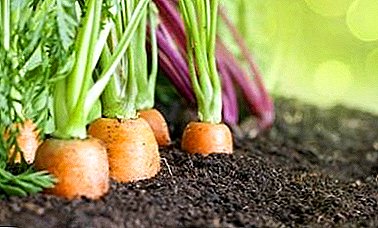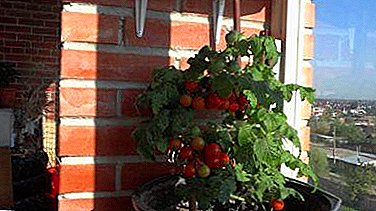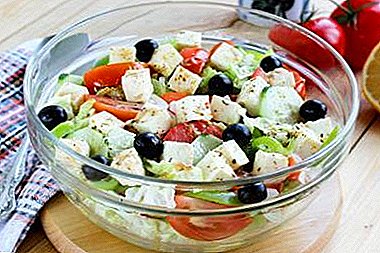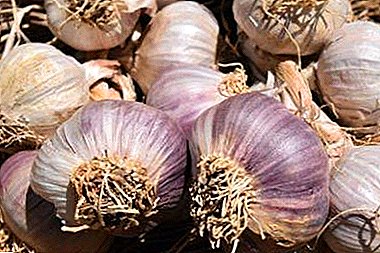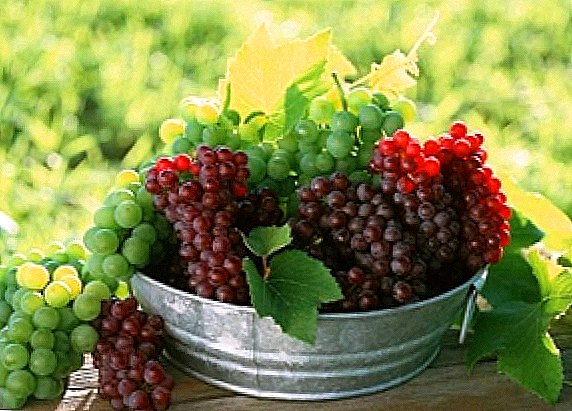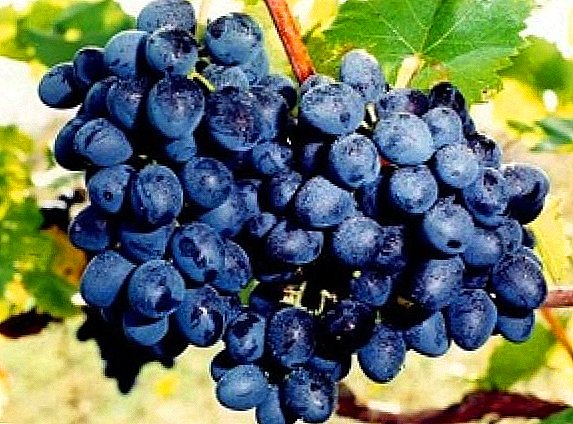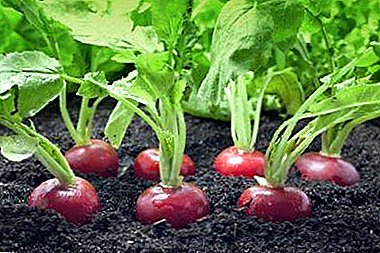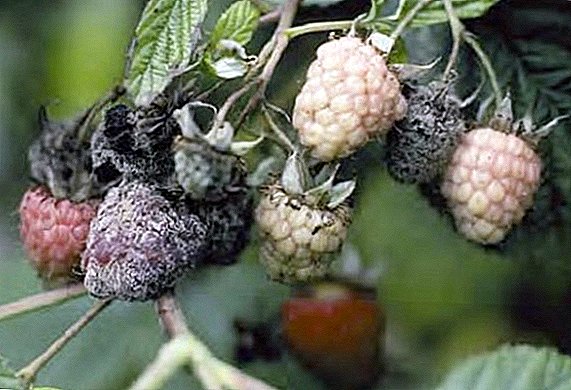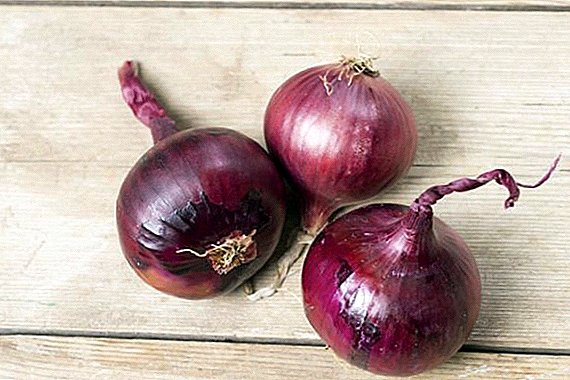 Onion "Red Baron" is famous for its excellent taste, as well as high yields. These features made it possible for the variety to spread widely among domestic summer residents, and also contributed to the plant acquiring a special status among the main crops. However, red onion varieties are not so easy to grow on their own plot, as their cultivation involves many complex agronomic processes. In this article we will look in detail at the main stages and main subtleties of the cultivation of the “Red Baron” variety, as well as we will define the basic principles of the cultivation of bulbs in modern vegetable growing.
Onion "Red Baron" is famous for its excellent taste, as well as high yields. These features made it possible for the variety to spread widely among domestic summer residents, and also contributed to the plant acquiring a special status among the main crops. However, red onion varieties are not so easy to grow on their own plot, as their cultivation involves many complex agronomic processes. In this article we will look in detail at the main stages and main subtleties of the cultivation of the “Red Baron” variety, as well as we will define the basic principles of the cultivation of bulbs in modern vegetable growing.
Variety description
"Red Baron" is a valuable agricultural variety that belongs to the first generation hybrids (F1). This means that the plant was bred by directly crossing two pure parental lines of homozygous red onion varieties. Like the other members of the Onion clan (Allium), Bulb family (Alliaceae), this variety belongs to perennial plants, but in agricultural production the full life cycle of a crop is no more than 12 months.
Did you know? Onions are actively used by man since antiquity. The first mention of the cultivation of this plant are found in ancient Egyptian culture, dating back to the III millennium BC. er
The leaves have a variety of tubular, green or blue-green hues. Like the rest of the species, the plant is characterized by a bulb - a modified part of the shoot, which serves as a reservoir for storing water and nutrients. It consists of a layer of succulent flakes, topped with a thin, dry film.  Bulbs are located on the so-called bottom - shortened stem process (no more than 1-2 cm in length). In the depths of Donets, behind the polynomial stratification of bulbous scales, buds are hidden, which can give life to daughter bulbs. The root system of onion is fibrous, it consists of numerous root processes.
Bulbs are located on the so-called bottom - shortened stem process (no more than 1-2 cm in length). In the depths of Donets, behind the polynomial stratification of bulbous scales, buds are hidden, which can give life to daughter bulbs. The root system of onion is fibrous, it consists of numerous root processes.
Find out what are the varieties of onions and what features of growing onions in the open field.
During the active growing season a flower arrow may appear on the plant, which reaches a height of about 1 m. The arrow is swollen and hollow, in its upper part a multicolor umbrella inflorescence is formed. Flowers of inflorescence are located on elongated stalks. They are not characterized by an abundance of shades, so the flowers are often snow-white or greenish-white tones. Perianth varieties are also greenish-white, it consists of 6 leaves and in diameter reaches no more than 1 cm. The plant blooms in the first half of summer (end of June - beginning of July). After flowering on the arrow, the fruit-box ripens, which contains small triangular seeds.  It has the "Red Baron" and its own distinctive features that help the plant stand out clearly against the background of related species. First of all, these include:
It has the "Red Baron" and its own distinctive features that help the plant stand out clearly against the background of related species. First of all, these include:
- bright reddish-purple shade of the bulbs;
- increased bulb size (by 10-20% relative to related varieties);
- extended and highly branched root system;
- unpretentiousness to soil conditions and resistance to drought;
- increased concentration in the bulbs of all kinds of phytoncides, microelements, vitamins, flavonoids, ascorbic acid and other compounds.
- high yield;
- the universality of the fruit;
- resistance to fusarium, root rot and peronospora;
- improved taste of the bulbs;
- the ability to bear fruit in almost any climatic conditions;
- bulbs have an excellent presentable and aesthetic appearance;
- high yield yield.
Familiarize yourself with the useful properties of onions and recipes for its use in traditional medicine.
 The drawbacks of this onion are practically non-existent. Its only drawback is the high popularity among summer residents of the CIS countries, therefore, during the period of active planting it is rather difficult to find and acquire the necessary amount of planting material. In addition, in connection with the high salable type of fruit, the seeds and sets of the “Red Baron” also differ in a rather high price.
The drawbacks of this onion are practically non-existent. Its only drawback is the high popularity among summer residents of the CIS countries, therefore, during the period of active planting it is rather difficult to find and acquire the necessary amount of planting material. In addition, in connection with the high salable type of fruit, the seeds and sets of the “Red Baron” also differ in a rather high price.
Did you know? In Russia, onions were actively used to combat various epidemics (typhoid, plague, cholera). For this bunch with bulbs hung in the corners of the premises. It was believed that such a measure helps to completely clean and disinfect the air from any infections.
Characteristics of onions and yield
"Red Baron" is characterized by medium early ripening, so it can be used for intensive vegetable production both in private summer cottages and for industrial purposes. In the temperate climate zone, harvesting is carried out 90 days after planting. This onion is also distinguished by high yields. The average yield of the variety is at least 2.5-3 kg per 1 sq. Km. m (about 30 tons per 1 ha). Regardless of the growing conditions, the fruits are characterized by high aromatic properties and taste, they are suitable for use both in raw form and for all kinds of culinary processing, including preservation.  Characteristic bulbs:
Characteristic bulbs:
- average weight - 20-30 g;
- shape - round, slightly oblate;
- juiciness - high;
- taste - sweet, semi-sharp, with a slight bitterness;
- the amount of vitamin C - up to 6.2 mg / 100 g;
- transportability - high.
To have fresh homemade herbs all year round, we advise you to familiarize yourself with tips on growing green onions on a windowsill.
Selection of planting material
The first thing to start with the cultivation of onions is the choice of quality seed. Traditionally, this plant multiplies in two ways, with the help of seeds and sevkah. Most often onions are grown by direct planting seedlings in open soil. Sale of planting material often starts in mid-February. At this time, you can purchase almost any amount of planting material of all known bulb varieties, so most gardeners stock up on the seasons during this particular period of the year.
Important! Seeds and planting should be purchased in advance, because in the high season (second half of March) there is a high probability of not finding the required amount of seed material.
 There are the following types of sevka:
There are the following types of sevka:
- fraction of 31-40 mm - the largest bulbs used for planting. Mostly they are planted to produce onion greens;
- fraction 21-30 mm - material that is used for sub-winter landing and exclusively for green mass in the autumn period of the year. It is not recommended to plant such a bow in the spring, as it often gives a huge number of arrows;
- fraction 15-20 mm - the most popular size of planting material, it is used both for receiving green mass of onions, and for growing fruit bulbs. Such a sevka is perfectly preserved, does not have an arrow and is distinguished by high viability;
- fraction of 8-14 mm - the smallest onions, they are used for both the production of greens and bulbs. Such sevok absolutely does not shoot, but quite often freezes.
After you have decided on the required fraction of the sev, it is necessary to look at the general condition of the onions. Quality and viable planting material must meet the following requirements:
- uniform color;
- the absence of any stains, mold and damage;
- dense and elastic structure of tissues (palpation);
- dry surface.
To protect yourself from low-quality onion bulbs, you also need to pay attention to the packaging. It must indicate the manufacturer, variety, storage conditions and the deadline for the implementation of the planting material. In addition, special attention should be paid to pre-storage storage set-up. Bulbs should be placed in a dry and ventilated place, with a temperature of + 10 ... +15 ° C and a relative humidity of 70-75%.
Familiarize yourself with Chinese onion cultivation.
 With long-term storage, the onions can be moved to the refrigerator, but in this case, sudden changes in temperature are strictly prohibited.
With long-term storage, the onions can be moved to the refrigerator, but in this case, sudden changes in temperature are strictly prohibited.
Planting material should gradually become accustomed to low temperatures over several days, as sudden drops (more than 1-2 ° C per day) can adversely affect its viability.
Important! Acquired sevok need to be dried at room temperature for several days, it will protect it from possible damage by pathogenic fungi in the future.
If you have to grow onions from seeds, you need to approach the purchase of seed with no less carefulness. The first thing you should pay attention to is the expiration date. High-quality onion seeds in optimal conditions (temperature + 15 ... +20 ° С, relative humidity - about 70%) are stored for no more than 2-3 years.
Also, be sure to pay attention to the labeling of the package, it should be applied to all relevant information (variety, period and conditions of storage, manufacturer, characteristics of seeds, varieties, etc.).  Special attention should be paid to the place of purchase. It is not recommended to buy seeds of siz hands either in spontaneous markets, since there is a high probability of acquiring low-quality seed material or counterfeit altogether.
Special attention should be paid to the place of purchase. It is not recommended to buy seeds of siz hands either in spontaneous markets, since there is a high probability of acquiring low-quality seed material or counterfeit altogether.
Familiarize yourself with the peculiarities of growing other types of onions: shallot, shnitt, leek, slizun, batun, multi-tiered.
An important factor when choosing a seed is the manufacturer. It is best to buy seed from eminent and proven producers, as often little-known seed enterprises neglect the general rules for maintaining the purity of the variety (including foreign producers). Acquired seeds must be checked for germination. To do this, take a small container with a volume of 50-100 ml, lay on their bottom filter paper or a small piece of gauze. Then on top of a layer of gauze or paper, you need to put 10 seeds, then moisten them with a small amount of water and put in a warm place for 7-10 days. At the end of the process, the number of germinated seeds is counted. On the basis of the data obtained, the germination percentage is determined, which should be at least 50% (5 out of 10 seeds gave a full-fledged sprout), otherwise the seeds are rejected.
At the end of the process, the number of germinated seeds is counted. On the basis of the data obtained, the germination percentage is determined, which should be at least 50% (5 out of 10 seeds gave a full-fledged sprout), otherwise the seeds are rejected.
Growing conditions
Onions often belong to unpretentious plants, so this agricultural species will give birth almost everywhere, regardless of the climatic characteristics of the region. The optimal temperature regime for this plant is within + 12 ... +16 ° С, however, its seasonal increase to + 25 ... +35 ° С is detrimental to the plant body. Onions are also resistant to cold, this fruit species is able to absolutely successfully withstand the spring temperature drops to -1 ... -3 ° С.
Onions - quite moisture-loving plant, especially in the first half of the growing season during the active growth of green mass.  Therefore, this plant requires mandatory daily watering until the full formation of the aerial parts. Subsequently, watering is reduced, since for the active formation of a full-fledged bulb, the plant requires a small dried peel on soil a few centimeters thick. 3-4 weeks before harvesting, watering should be completely stopped, it will help to increase the size and total weight of the bulbs.
Therefore, this plant requires mandatory daily watering until the full formation of the aerial parts. Subsequently, watering is reduced, since for the active formation of a full-fledged bulb, the plant requires a small dried peel on soil a few centimeters thick. 3-4 weeks before harvesting, watering should be completely stopped, it will help to increase the size and total weight of the bulbs.
Particularly demanding variety to the place of cultivation. The plant requires open, well-lit areas, away from any tall vegetation, but always with gentle airing. Groundwater in such a place should lie at the maximum depth, otherwise it can cause putrefactive damage to the bulbs.
Soil and fertilizer
Like all onions, the Red Baron responds well to a rich and well-fertilized soil with a neutral or slightly alkaline pH (6.5-7.9). The highest yields are observed on loamy soils well-fertilized with peat, with a sufficient amount of humus compounds. However, it is possible to grow rich harvests on poorer soils. In this case, it is necessary to resort to the enrichment of the soil with organic fertilizers.
Important! Onions should not be grown on heavy soils, since such soils often form a dense and durable crust, which at times reduces the germination of plants.
To successfully grow onions in the garden, the soil requires additional fertilizer. To do this, for each square meter of future plantations need to make about 2 buckets of peat, compost or rotted manure, as well as 1 tbsp. spoon (15-20 g) double superphosphate and potassium chloride, after which all carefully dig. Peat and compost can be replaced with chicken manure (0.2 kg / m2) or wood ash (0.5 kg / m2).  Fertilizing fresh dung soil under the bow is not worth it, as it can cause fungal diseases of plants, as well as the active spread of weed seeds and other pests. In addition, it is necessary to protect the onions and from nitrogen compounds (nitrate, urea, etc.), since they intensify the active growth of the green mass of the plant, and not the bulbs.
Fertilizing fresh dung soil under the bow is not worth it, as it can cause fungal diseases of plants, as well as the active spread of weed seeds and other pests. In addition, it is necessary to protect the onions and from nitrogen compounds (nitrate, urea, etc.), since they intensify the active growth of the green mass of the plant, and not the bulbs.
Particular attention should be paid to the predecessor of the onion. This crop is best fruited after varieties requiring a huge amount of organic fertilizer. These include: cabbage, pumpkin, zucchini, cucumber, tomato, early potatoes and legumes. It is not advisable to grow a plant after fruit crops such as garlic, carrots, radishes and celery. It is best to cultivate this fruit species 3-5-year system of crop rotation, which excludes the cultivation of "Red Baron" that one and the same plot more often than 1 time in 3-5 years.  When planting onions in the summer cottage, you should also pay attention to the neighbors in the garden: the most favorable culture gets along with cabbage, parsley, beetroot, carrots, spinach, lettuce, tomato. Avoid the neighborhood of onions with fruit trees and shrubs, as well as peas and beans. Otherwise, it will negatively affect the quantity and quality of the crop.
When planting onions in the summer cottage, you should also pay attention to the neighbors in the garden: the most favorable culture gets along with cabbage, parsley, beetroot, carrots, spinach, lettuce, tomato. Avoid the neighborhood of onions with fruit trees and shrubs, as well as peas and beans. Otherwise, it will negatively affect the quantity and quality of the crop.
Did you know? Despite the fact that onions are a rather demanding receiver, the culture itself is one of the best predecessors for almost all cultivated plants.
Growing from seed to seedlings at home
The germination of seeds for seedlings is one of the most common methods of obtaining resistant and viable plants that can later provide high and high-quality yields. However, when germinating seeds of bulbous growers will certainly encounter many difficulties arising from the physiological characteristics of the crop. Therefore, before proceeding to the germination of the seeds of the Red Baron, it is necessary to become familiar with the main subtleties of this process.
Seed preparation
Seeds of onions are distinguished by a rather low germination rate, therefore, the procedure for the preliminary preparation of seed material must necessarily follow the germination of seeds. One of the main stages of this procedure is the disinfection of seeds from a variety of pathogenic microorganisms and fungal spores. For this, the seeds are soaked in a weak solution of potassium permanganate (1 g of powder / l of pure water) for 45 minutes or in a 70% alcohol solution for 10-15 minutes, and then washed with clean boiled water.  To improve the growth of seed, it is recommended to process biostimulants based on natural components. The best solution for these purposes is Epin, in which the seeds are soaked for 18-20 hours, but you can use any other analogues to choose from. After processing, the seed material is dried naturally to a friable state for 1-2 days.
To improve the growth of seed, it is recommended to process biostimulants based on natural components. The best solution for these purposes is Epin, in which the seeds are soaked for 18-20 hours, but you can use any other analogues to choose from. After processing, the seed material is dried naturally to a friable state for 1-2 days.
Content and location
After careful pre-treatment, the seeds are ready for germination. They grow up seedlings in warm and maximally sunny corners of the house, far from sharp drafts and temperature drops, at a distance of at least 2-3 meters from the window and door. To do this, use individual garden cassettes or common containers with a height of about 8-10 cm. In their absence, you can use other containers available on the farm, up to the usual plastic cups.  Practically any ready-made substrate from the nearest garden shop will be suitable for sprouting onions. But in order to create the most comfortable conditions for development for the plants, the soil is prepared independently. To do this, mix compost, peat and garden soil in equal parts. Regardless of the origin of the soil, it must be treated against all kinds of fungi - the main pests of seedlings. For this purpose, complex fungicides are introduced into the soil.
Practically any ready-made substrate from the nearest garden shop will be suitable for sprouting onions. But in order to create the most comfortable conditions for development for the plants, the soil is prepared independently. To do this, mix compost, peat and garden soil in equal parts. Regardless of the origin of the soil, it must be treated against all kinds of fungi - the main pests of seedlings. For this purpose, complex fungicides are introduced into the soil.
Seed planting process
Seeds are sown 40-45 days before the proposed date of onion transplantation in open soil. In the temperate zone, this period falls to the end of March - the beginning of April. Sowing is carried out by row or well-hole method, to choose from. During well-sowing, small chaotic holes about 1 cm deep are made in the soil, at a distance of 3-5 cm from each other.  When rowed in seedling containers, parallel rows about 1 cm in depth are cut at a distance of 4-5 cm from each other. For convenience, the rows are laid out parallel to the long side of the pot, which further facilitates the care of the seedlings. The distance between the individual seeds in a row should be within 3 cm; otherwise, thickened sowing may cause general inhibition of plant growth.
When rowed in seedling containers, parallel rows about 1 cm in depth are cut at a distance of 4-5 cm from each other. For convenience, the rows are laid out parallel to the long side of the pot, which further facilitates the care of the seedlings. The distance between the individual seeds in a row should be within 3 cm; otherwise, thickened sowing may cause general inhibition of plant growth.  Sowing of prepared seeds is carried out with the help of tweezers or thin sticks. This makes it possible to accurately distribute the seeds over the entire surface of the soil. After filling with seeds of all the holes, they are covered with a layer of soil of 1 cm and watered abundantly. In order for the seedlings to rise qualitatively, it is necessary to create the necessary moisture and temperature conditions for the onion. For this, seeded dishes are covered with a thick transparent plastic film.
Sowing of prepared seeds is carried out with the help of tweezers or thin sticks. This makes it possible to accurately distribute the seeds over the entire surface of the soil. After filling with seeds of all the holes, they are covered with a layer of soil of 1 cm and watered abundantly. In order for the seedlings to rise qualitatively, it is necessary to create the necessary moisture and temperature conditions for the onion. For this, seeded dishes are covered with a thick transparent plastic film.  In such conditions, a local greenhouse effect is created, which favorably affects the viability of the seed material, so within 15-20 days you can get full-fledged plants.
In such conditions, a local greenhouse effect is created, which favorably affects the viability of the seed material, so within 15-20 days you can get full-fledged plants.
Did you know? China is considered the absolute leader in onion production. At least 20 thousand tons of this vegetable is grown in this country every year.
Seedling care
Before the appearance of the first gatherings, the containers planted with onions are kept at a temperature of + 20 ... +25 ° С. In such conditions, the plants do not require painstaking care, at this stage only periodic watering of the soil is carried out. Approximately 3 weeks after sowing, full-grown sprouts of future seedlings appear. At this stage, it is necessary to remove the film from the containers and move them to a cooler, but sunny place with a temperature of about + 16 ... + 20 ° С. Otherwise, the seedlings will be excessively actively pulled upwards, which will lead to its emergence.  Watering of young plants is carried out as necessary, after a small dry peel appears on the soil. Seedlings require gentle irrigation, otherwise an overabundance of moisture can cause its death. To improve onion growth, plants are additionally fed with complex mineral fertilizers.
Watering of young plants is carried out as necessary, after a small dry peel appears on the soil. Seedlings require gentle irrigation, otherwise an overabundance of moisture can cause its death. To improve onion growth, plants are additionally fed with complex mineral fertilizers.
To do this, dissolve in 1 l of water:
- superphosphate - 2 g;
- potassium chloride - 0.5 g;
- urea - 1 g
 A week before planting the seedlings in the open soil, the plants are necessarily quenched. This measure makes it possible to best prepare them for growth in natural conditions, as well as to minimize the death of young onions. To do this, throughout the week, containers with plants are kept daily in the open air. For the first time, seedlings are brought out into the street closer to noon, for 3-4 hours. Then every day this time interval is doubled, up to a full transfer to fresh air. After 2-3 nights in the open air, seedlings are ready for transplantation into natural conditions.
A week before planting the seedlings in the open soil, the plants are necessarily quenched. This measure makes it possible to best prepare them for growth in natural conditions, as well as to minimize the death of young onions. To do this, throughout the week, containers with plants are kept daily in the open air. For the first time, seedlings are brought out into the street closer to noon, for 3-4 hours. Then every day this time interval is doubled, up to a full transfer to fresh air. After 2-3 nights in the open air, seedlings are ready for transplantation into natural conditions.Important! During quenching, be sure to reduce watering onions, it will help the plants to prepare for a possible drought.
Transplanting seedlings to ground
Young onions are transplanted into the open soil at the beginning or in the middle of May, at which time the stabilization of the weather regime is observed, as well as an increase in the average daily temperature to + 10 ° C. At this point, the plants must be hardened, and also have the appropriate age (at least 40 days after seeding). Seedlings are planted in pre-fertilized, plowed and cleaned from weeds and all sorts of plant residues soil.  Onions are grown in a rowed way; for this purpose, solid rows with a row spacing of 30 cm are cut throughout the site. Young plants are carefully planted in each of the holes at a distance of 5 cm from each other. In this case, the root system should not be deepened by more than 1 cm, otherwise it will adversely affect the growth rate of the onions. After transplanting the beds plentifully watered. The most optimal period of the day for planting is the evening from 17:00 to 20:00, since only at this time will it be possible to avoid the negative impact of solar radiation on weakened sprouts.
Onions are grown in a rowed way; for this purpose, solid rows with a row spacing of 30 cm are cut throughout the site. Young plants are carefully planted in each of the holes at a distance of 5 cm from each other. In this case, the root system should not be deepened by more than 1 cm, otherwise it will adversely affect the growth rate of the onions. After transplanting the beds plentifully watered. The most optimal period of the day for planting is the evening from 17:00 to 20:00, since only at this time will it be possible to avoid the negative impact of solar radiation on weakened sprouts.
Young "Red Baron" is a thin and elegant blade of grass, so you need to carefully remove the seedlings from the containers so as not to damage the tender sprout and its root. For this purpose, the soil is abundantly moistened, up to a glut, which contributes to the almost complete softening of the substrate. After this, the edges of the container with the seedlings are slightly squeezed, and then the entire contents of the pot are removed. The soil with plants is divided into small parts, and then into areas with individual plants.
Cultivation from sevka in open ground
Growing onions from seedlings is the most common breeding method for this agricultural species. This method has many advantages over sowing seeds, one of which is simplicity, convenience and high efficiency. But in order to get a high-quality and rich harvest, it is necessary to adhere to the general rules of agrotechnics when growing bulbous.
Site selection and soil preparation
The cultivation of onions from sevka begins with the preliminary preparation of the site and soil for plantations. Traditionally, this culture is grown in the open air, as onions are one of the most unpretentious varieties of cultivated plants. However, if you plan to grow onions on a feather from early spring to late autumn, you cannot do without additional shelter. For this purpose, temporary greenhouses made of polyethylene film are created on the site, which make it possible to actively increase the green mass throughout the frost-free period of the year.  As mentioned above, the bow loves spacious and well-lit areas, so open sunny areas are chosen for this crop, far from all kinds of obstacles and tall vegetation, with low groundwater levels. Soil preparation for planting begins in the fall. At this time, any vegetation is removed from the site, and organic fertilizers are applied, after which the soil is carefully plowed to a depth of 25-30 cm.
As mentioned above, the bow loves spacious and well-lit areas, so open sunny areas are chosen for this crop, far from all kinds of obstacles and tall vegetation, with low groundwater levels. Soil preparation for planting begins in the fall. At this time, any vegetation is removed from the site, and organic fertilizers are applied, after which the soil is carefully plowed to a depth of 25-30 cm.
In the spring comes the next stage of soil preparation. After the snow melts and the onset of the temperature optimum, the soil is again plowed for planting, having preliminarily enriched it with a nitroammofoska with a calculation of 15 g / 1 sq. M. plot. Excessively poor soils require additional organic dressing, for this, before plowing, peat, compost or rotted manure are applied to the site.
Seed preparation
After the plot is ready for planting, you can proceed to the preparation of planting. The first thing to start with is to remove excess peel from the onions, as well as all kinds of rubbish, and then slightly trim the dry part of the top. The procedure should be carried out carefully so as not to hurt the sprout.  Pruning makes it possible to intensify the onion germination, as well as to free the sprout from the excess barrier. Pruning is not a mandatory measure for preplant preparation of the hay, but this procedure has a positive effect not only on the germination of onions, but also on the energy of their growth.
Pruning makes it possible to intensify the onion germination, as well as to free the sprout from the excess barrier. Pruning is not a mandatory measure for preplant preparation of the hay, but this procedure has a positive effect not only on the germination of onions, but also on the energy of their growth.
After cleaning and trimming, it is necessary to warm up well, as it stimulates them to active growth, and also helps to avoid marksmanship. Heating is carried out by dry heat at a temperature of about + 30 ... +35 ° C for 6-7 hours. To prevent the death of young plants from various infections and pests sevka necessarily disinfect.
Sterilization is carried out immediately before planting. For this, the onions are soaked for 2 hours in a 1% solution of potassium permanganate or for 10-15 minutes in a solution of blue vitriol (1 tsp / 10 l of water). In the system of organic farming, copper sulphate and potassium permanganate are replaced by biofungicides based on natural components (“Gamair”, “Planriz”, “Fitosporin”). In this case, soaking before planting spend at least 1-2 hours.
We advise you to find out what is the best way to soak the onions before planting.
The process of planting sevka in the ground
The prepared planting material is planted in a row manner with an aisle of about 20-25 cm (this allows airing the beds). Planted in a row at a distance of at least 6 cm from each other. If you are faced with the task of obtaining particularly large onions, then it should be increased to 10-12 cm. Onion plants are planted to a depth of 4-5 cm, then densely covered with soil and mulched with peat 2-3 cm. After planting, the area is poured with plenty of water and is left at rest until the first shoots.
Did you know? According to UN research, onions are the most popular vegetable in the world. Culture is massively grown in 175 countries around the world, while wheat is grown in no more than 90 countries.
Watering
A fruit crop such as onions does not require excessive soil moisture, since its extensive root system can provide plants with available moisture from the soil even during periods of prolonged drought. However, for the normal formation of the aerial part in the early stages of development, the onion requires a sufficiently large amount of moisture, therefore, for the first 2 months, the soil must be periodically moistened at least 1-2 times a week (depending on the temperature regime). To do this, use clean distilled water at room temperature (but not more than +30 ° C).  During periods of drought, the multiplicity of the procedure is increased, but at the same time, watering is carried out only after the characteristic slightly dried peel appears on the ground. By the middle of July, watering is gradually reduced, and 2-3 weeks before the harvest, it is completely stopped. This measure contributes to the active growth of the bulb, as well as additional storage of all sorts of useful substances. Also, onions do not need additional irrigation during long rain periods, as this may adversely affect the growth and development of the bulbs and even cause rot of the plants.
During periods of drought, the multiplicity of the procedure is increased, but at the same time, watering is carried out only after the characteristic slightly dried peel appears on the ground. By the middle of July, watering is gradually reduced, and 2-3 weeks before the harvest, it is completely stopped. This measure contributes to the active growth of the bulb, as well as additional storage of all sorts of useful substances. Also, onions do not need additional irrigation during long rain periods, as this may adversely affect the growth and development of the bulbs and even cause rot of the plants.
Soil loosening and weeding
Timely loosening and weeding are among the most important conditions for obtaining high yields of onions. “Red Baron”, like most other cultivated plants, is not highly competitive, therefore the development of all kinds of weeds on the plot can cause a sufficiently serious inhibition of plant growth and their ability to form a large and juicy bulb.
That is why periodic weeding is an obligatory component of the general agrotechnology of onion cultivation. During weeding, it is also necessary to thoroughly gnaw the soil, which has a positive effect on the quality of future bulbs. With a dense soil crust, a thick and juicy neck is formed in the onion bulbs, which in the future becomes the main reason for the decrease in onion quality and subsequent problems associated with its storage.  Onions need loosening Weeding and loosening is carried out qualitatively, to a depth of 7-10 cm, at least 1 time per week. It is especially important to observe weekly weeding in the first months of onion growth, as rapidly developing weeds can cause the death of young shoots. The most favorable period for this will be evening or morning time on a dry and sunny day. Mandatory weeding and loosening is carried out after prolonged rains, as excessive moisture leads to soil compaction, and also stimulates the growth of weeds.
Onions need loosening Weeding and loosening is carried out qualitatively, to a depth of 7-10 cm, at least 1 time per week. It is especially important to observe weekly weeding in the first months of onion growth, as rapidly developing weeds can cause the death of young shoots. The most favorable period for this will be evening or morning time on a dry and sunny day. Mandatory weeding and loosening is carried out after prolonged rains, as excessive moisture leads to soil compaction, and also stimulates the growth of weeds.
Top dressing
Proper feeding is a prerequisite for high-yield onion plants. It is carried out twice, at the beginning of the active growing season and in the middle of the season. For the first time, seedlings are fed into the phase of active growth of leaves, 2-3 weeks after planting the planting material into the soil.
Learn more about fertilizing onions with organic and mineral fertilizers.
During this period, plants are often fed with highly active nitrogenous fertilizer, the most popular of which is urea. From it prepare water solutions at the rate of 10-15 g / 5 l of water. Substance contribute under the root, replacing one of the irrigation procedures, the average fluid flow rate is about 5 liters / 1 square meter. plantings. In the leaf growth phase, onions also respond well to a nitrophosphate or nitroammofosk, especially on poor soils. Fertilizer is applied in a dry form with a solution of urea, with a calculation of 25-30 g / m2. plantings.
VIDEO: TRAINING OF ONION GOLD The following feeding is carried out in 3-4 weeks after the first. At this time, the onion needs an additional amount of easily assimilable sources of potassium and phosphorus, therefore the plants are fed with an aqueous solution based on superphosphate (10-15 g / 5 l of water) and potassium salt (5-7 g / 5 l of water). You can replace the potassium phosphate dressing with a solution of nitroammophoska (20 g / 5 l of water). Fertilizer is applied at the root, with a calculation of 5 liters of liquid per 1 square meter. plantings.
Important! After feeding onions, be sure to wash with running water, otherwise highly concentrated solutions can cause burns of plants.
Pests, diseases and prevention
All sorts of pests and diseases are one of the most serious problems that every vegetable grower faces when growing onion varieties. Despite the fact that "Red Baron" is distinguished by increased resistance to fusarium, root rot and peronosporosis, plants can be actively affected:
- gray rot;
- Donets rot;
- jaundice.
 For these purposes, solutions are used based on liquid soap (1 tbsp. L / 10 l of water) with the addition of copper sulphate (1 tsp. / 10 l of water) or copper oxychloride (1 tsp. / 10 l of water). The resulting solution is abundantly wetted above-ground parts of plants, as well as basal soil. The most favorable period for this will be morning or evening in dry sunny weather. The treatment is carried out 1-2 times per season when the onions reach a total length of at least 10-15 cm. Also, for prophylaxis, experienced gardeners recommend resorting to pollination of the plantations with tobacco dust or wood ash. The procedure is carried out 2 times per season during the active growing season of plants with a break of 20-25 days.
For these purposes, solutions are used based on liquid soap (1 tbsp. L / 10 l of water) with the addition of copper sulphate (1 tsp. / 10 l of water) or copper oxychloride (1 tsp. / 10 l of water). The resulting solution is abundantly wetted above-ground parts of plants, as well as basal soil. The most favorable period for this will be morning or evening in dry sunny weather. The treatment is carried out 1-2 times per season when the onions reach a total length of at least 10-15 cm. Also, for prophylaxis, experienced gardeners recommend resorting to pollination of the plantations with tobacco dust or wood ash. The procedure is carried out 2 times per season during the active growing season of plants with a break of 20-25 days.Onions are also actively affected by the following pests:
- onion fly - The parasite lays eggs in the tissues of the plant, from which the larvae that infect the bulb mature. This causes wilting and rotting of the plants. Fight insects with an aqueous solution of sodium chloride (300g / 10 l). The plants are abundantly treated with liquid, as well as the root zone of the garden. The procedure is carried out daily for 10 days. If necessary, repeat the course;
- onion root mite - the insect feeds on the juice and tissues of the onion, which reduces its overall immunity, as a result of which fungal lesions of the plantations occur. Joint fungal insecticidal invasion leads to wilting and death of onions. They fight the pest by spraying the beds with a 0.2% solution of the “Keltan” preparation or an interchangeable analogue. The treatment is carried out once and, if necessary, repeated;
- onion moth - small winged insect from the order Lepidoptera. The insect feeds on plant tissues, which causes wilting of green mass and death of onions. Fight against the pest with the help of any complex insecticide for bulbous.



To prevent the development of parasites on the bow, before planting, the seedlings are treated with solutions of potassium permanganate, copper sulfate or alcohol according to the technology described above. During the active growing season onions, you can resort to pollination of plantations with wood ash or tobacco dust. Replace pollination by treating the soil and plants with tobacco-pepper solution. To do this, 200 g of tobacco is steamed in 3 liters of water for three days, after which the broth is filtered and 1 tsp added to it. ground pepper and 1 tbsp. l liquid soap. The resulting solution is diluted in 10 liters of water, and then used for spraying plants, the flow rate of the working fluid is about 5 l / m sq.
Learn about other pests that affect onions and how to deal with them.
Preventive treatment of onions against pests is carried out periodically, at least 1 time per month. The best time for this is morning or evening in dry and sunny weather. In addition, strict adherence to the agrotechnology of growing the plant, including timely weeding, as well as loosening the soil to a depth of at least 7 cm, can prevent the onions from becoming infected by insects.
Harvesting and storage
The harvest period of the Red Baron largely depends on the climatic conditions and the temperature regime of the growing region of the variety. But in most cases this moment comes about 90 days after planting the planting material in the open ground, which falls on the second half - the beginning of September. Уборку дозревшего лука проводят немедленно, в противном случае луковицы могут повторно дать молодые корешки, что в дальнейшем негативно скажется на лёжкости плодов.  Главными сигналами готовности лука к уборке являются следующие признаки:
Главными сигналами готовности лука к уборке являются следующие признаки:
- полное прекращение роста новых листочков на растениях;
- увядание и пожелтение ботвы;
- mass lodging above-ground part of the onion;
- onion neck characteristically thin and soft;
- the bulbs acquire a rich reddish-purple hue.
During the primary drying, the remnants of nutrients from the green mass gradually pass into the bulb, so at this stage you should not cut the tops. After the primary drying, dry tops and roots are cut, and you should definitely leave a small tail 3-4 cm long. Dig onions from the soil and cut the tops. Cut the bulbs carefully for any damage or infectious lesions, after which the rejected crop is removed for disposal. Next, the bulbs are subjected to re-drying for 7-10 days at a temperature of + 25 ... +30 ° C or 10-12 hours at a temperature of about +40 ° C.
Dig onions from the soil and cut the tops. Cut the bulbs carefully for any damage or infectious lesions, after which the rejected crop is removed for disposal. Next, the bulbs are subjected to re-drying for 7-10 days at a temperature of + 25 ... +30 ° C or 10-12 hours at a temperature of about +40 ° C.
Important! The collected bulbs should not be washed, since their excessive moisture will negatively affect the curing.After re-drying the onions are moved to a permanent storage place. Store onions in wooden or plastic boxes, in fabric bags, as well as in plastic nets. It is best suited for this dry, dark, well-ventilated rooms with a temperature optimum from 0 to +3 ° C. In such conditions, the fruits are perfectly preserved from 6 to 12 months. To improve the yield quality of the crop, the bulbs should be packaged in small fabric or mesh bags and suspended from the ceiling. This will help to avoid excessive moisture of the bulbs during storage, since moisture almost always becomes the main cause of rotting onions.
Possible problems and recommendations
When growing onions, every vegetable grower will certainly face many difficulties that often threaten the future harvest with full or partial destruction. The most common among them are all sorts of plant pathologies, which soon lead to their withering. Therefore, before the active cultivation of onions, it is necessary to get acquainted with the most dangerous among them.
So, while growing an onion, the grower can observe the following phenomena:
- arrowhead plants - is a consequence of non-compliance with the general agrotechnology of cultivation of culture and storage conditions of planting material. The appearance of arrows inhibits the growth and development of the bulbs, which reduces their capacity and total mass. Pathology is not amenable to treatment, but to improve the growth of the bulbs, it is recommended to completely cut the peduncles;
- yellowing and wilting of young leaves - the phenomenon has an abiotic or biotic nature. To eliminate the disease, onions are treated with complex means of protection against infections and pests, and they also regulate the general agrotechnical method of growing crops;
- putrid lesions - are the result of excessive soil moisture, in order to eliminate the pathology, adjust the intensity and frequency of watering the plantations;
- tarnish of onion green - occurs as a result of a lack of nitrogenous compounds in the soil, to eliminate the pathological process of planting is fed with a solution of urea (10-15 g / 5 l of water);
- wilting and twisting onion feathers - caused by a lack of potassium in the soil, to eliminate violations of the plant are fed with solutions of potassium salt (5-7 g / 5 l of water);
- excessive bitterness of the bulbs - caused by the excessive accumulation of onions of specific substances, the so-called glycosides. Their excessive accumulation is provoked by an excess of sun, high temperatures, mineral compounds in the soil, as well as a lack of moisture in the soil. To prevent onion bitterness, it is recommended to observe the permissible norms of fertilizers when mineral fertilizing plants, as well as general conditions for growing the crop.


- Before planting onions, it is imperative to check the acidity of the soil, since even slight acidification of the soil can cause the growth of the culture to be inhibited;
- The agrotechnology of growing onions should be strictly followed, including general measures to prevent the development of pests and various infections;
- the onion does not like excessive moisture, but you should not forget about its watering, since drought can cause a decrease in the commercial value of the bulbs;
- For the cultivation of onions from seedlings, it is necessary to use medium-sized onions (about 2 cm), otherwise plant shooting cannot be avoided;
- growing onions involves a 3-5-year system of crop rotation, otherwise high yields from the crop will not be achieved.
 "Red Baron" is a modern and highly productive variety of onions, which every year conquers more and more territories in domestic summer cottages. This vegetable has a high taste characteristics, as well as a high content of all kinds of vitamins and other nutrients, which makes it almost indispensable in the daily diet. But, despite its unpretentiousness, this plant requires special care for itself, as well as the climate regime. Otherwise, to achieve high-quality and high yields on their own plot will not be so easy.
"Red Baron" is a modern and highly productive variety of onions, which every year conquers more and more territories in domestic summer cottages. This vegetable has a high taste characteristics, as well as a high content of all kinds of vitamins and other nutrients, which makes it almost indispensable in the daily diet. But, despite its unpretentiousness, this plant requires special care for itself, as well as the climate regime. Otherwise, to achieve high-quality and high yields on their own plot will not be so easy.
Reviews




